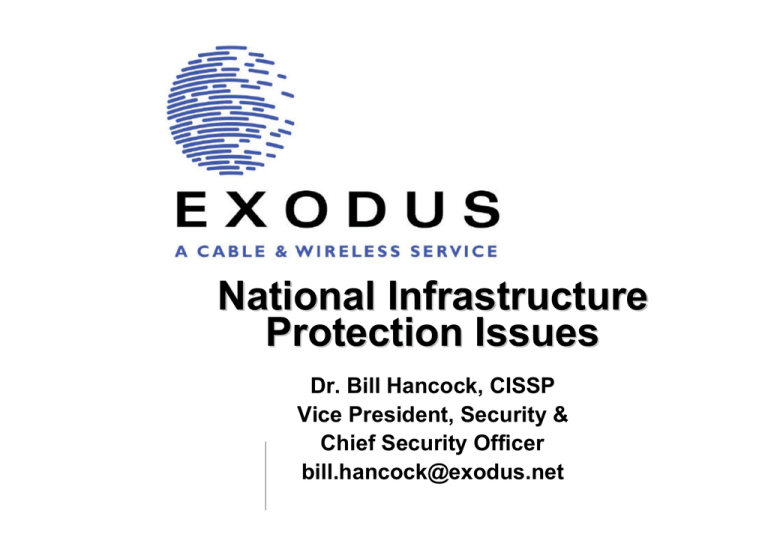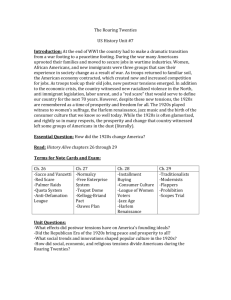National Infrastructure Protection Issues Dr. Bill Hancock, CISSP Vice President, Security &
advertisement

National Infrastructure
Protection Issues
Dr. Bill Hancock, CISSP
Vice President, Security &
Chief Security Officer
bill.hancock@exodus.net
What is Protection in
Cyberspace?
• Depends on who you talk to – everyone has an
opinion and they vary dramatically
• Basic definition: stopping someone from
taking something that is not theirs
• Sometimes, things are taken by force
• Who is hurt varies
l
l
l
Sometimes companies
Sometimes people
Sometimes - you
The Speaker’s Perspective…
•Came from various large and small companies in networking
and security over 30 year career
•Have designed or redesigned over 4000 networks, many in
critical infrastructures (power, water, public safety)
•Have designed protocols, have patents, etc.
•Have been on several White House committees on critical
infrastructure and Chair NRIC FG1B (cyber security)
•Currently responsible for security on the world’s largest
multinational IP network infrastructure:
l THE Internet backbone
– Bought from MCI in 1996/1997
• 2.2m IP nodes active on network
• Data, voice, video
l
World’s largest hosting provider
•
•
•
•
•
l
50% of top 100 web sites in the world
Hundreds of thousands of servers, millions of users
One of every three mouse clicks…
One of the largest operational security teams
Over 1000+ cyber attacks per month
THE telephone company in many countries (C&W)
Eastern Telegraph Company
Global Infrastructure:
The Cable and Wireless Internet
Services (Exodus/CWIS) Network
As of end of Q4 ’01
Global Infrastructure:
CWIS Internet Data Centers
Clients Rely on Exodus/CWIS
Some Statistics…
•43 Internet data centers globally deployed
•Dial-up POPs/NAPs in 170+ countries
•Over 4000 customers in IDCs alone
•One of the largest IP networks in the world growing
at over 30% per year (or more)
•Operates the Tier 0 Internet Backbone
•The phone company in many countries
•Over 50m users per day traverse networks (peak in
2001 was 87m in one day)
•One of the largest operational cyber security teams
in the world with some of the most skilled security
practitioners in the world
•Participants in cyber security teams with
governments in many countries of the world
Critical Infrastructure
Assessment Office (CIAO)
•Part of the U.S. National Critical Infrastructure
Assessment Board (CIAB)
•Declared Exodus/CWIS a Type 1 CIAO in
March, 2000
l
Outages determined to cause critical national harm
to U.S. economy
•Works closely with Exodus/CWIS in many
areas to help identify critical resources and
work with government partnerships to share
information and ideas to correct
•Now part of National Security Council,
reporting to National Security Advisor (Dr.
Condalezza Rice)
Security is Very Complex
PKI Manager
Centralized
Security
Policy Manager
Token Card
Manager
Other Security
Entity Manager
Certificate
Authority
Interface
Digital
Signature
Interface
OS Security
Management
Tools
Single Sign-on
Tools
Network
Virus Interception
& Correction
Security Policy
Distributor
Cyberwall/Firewall
Rule Base
Security Event
Report
Writer(s)
Host-based
Application-based
VPN Session or
Tunnel
Manager
Connection
Manager and
Logging
Application Proxy
Implementations
Encryption
Facilities for
Network
Connections
Authentication
Cryptography
VPN IPSec and
VPN
Connection
Manager
Security Traffic
Event Analyzer
Application
Logging Facility
Intrusion
Logging
Anti-Virus
Intrusion Detection
Intrusion
Detection
Security Event
Logging
Security Integrity
Manager
Intrusion
Prevention
Auditing
• Security is currently
where networking was
15 years ago
• Many parts & pieces
• Complex parts
• Lack of expertise in
the industry (60%
vacancy with no
qualified personnel)
• No common GUIs
• Lack of standards
• Attacks are growing
• Customers require
security for biz
Security Management
Stateful
Inspection
Security
Filter Engine
Packet
Inspection
Frame
Inspection
Network Access
Control Interception
and Enforcement
Facility
Application
Inspection
Real-time
Frame
Management
As Systems Get Complex, Attackers
are Less Sophisticated…
HIGH
CROSS SITE SCRIPTING
INTRUDER KNOWLEDGE
“STEALTH”/ADVANCED
SCANNING TECHNIQUES
DENIAL OF SERVICE
STAGED
ATTACK
PACKET SPOOFING
SNIFFERS
DISTRIBUTED
ATTACK TOOLS
WWW ATTACKS
AUTOMATED PROBES/SCANS
SWEEPERS
BACK DOORS
GUI
NETWORK MANAGEMENT DIAGNOSIS
DISABLING AUDITS
ATTACK
SOPHISTICATION
HIJACKING
SESSIONS
BURGLARIES
EXPLOITING KNOWN VULNERABILITIES
PASSWORD CRACKING
SELF-REPLICATING CODE
PASSWORD GUESSING
LOW
1980
1985
1990
1995
2000
Software Is Too Complex
50
45
Sources of Complexity:
Always-on connections
l
IP stacks in cell phones, PDAs,
gaming consoles, refrigerators,
thermostats
15
16.5
10
3
4
0
WINDOWS XP (2001)
l
18
20
WINDOWS 2000 (2000)
l
• XML, SOAP, VoIP
Complex Web sites
WINDOWS 98 (1998)
New Internet services
30
WINDOWS NT 4.0 (1996)
l
35
WINDOWS 95 (1995)
Data mixed
with programs
WINDOWS NT (1992)
l
40
WINDOWS 3.1 (1992)
Applications and operating systems
MILLIONS
l
Security Must Make Business
Sense to Be Adopted
OPTIMAL LEVEL OF SECURITY
AT MINIMUM COST
COST ($)
TOTAL COST
COST OF SECURITY
COUNTERMEASURES
0%
COST OF SECURITY
BREACHES
SECURITY LEVEL
100%
Some Reality on Infrastructure
Security in the Private Sector
•Statistics show that post 9/11/01, security sales
have NOT increased due to heightened
awareness of security threats
•Corporate management will NOT spend money
on security and reliability issues unless:
l
l
l
l
l
There is a REAL operational requirement
There is a legal requirement
There is the threat of bad public relations or press
There is some perceived Return on Investment (ROI)
There are government incentives to do so
•Most critical infrastructure networks continue
to be vulnerable to a wide range of attacks
Security Lifecycle Solutions
Design
Assess
Requirements Analysis
Risk Assessment
Product/Service Evaluation
Trade-Off Study
Compliance Verification
Architecture Review
Application Testing
SSE-CMM
ISO 9000
SAS 70
Secure Architecture and
Code Design
Business
Continuity/Disaster
Recovery Planning
PKI Solutions
Policy and Procedures
Site Evaluation
BS 7799
Monitor
Incident Response and
Recovery
Vulnerability Scans
Penetration Testing
Alert Monitoring
Log Analysis
System Audit
Integrity Monitoring
Implement
Training
Firewall/IDS Configuration
VPN
OS Hardening
Roles & Responsibility
Integration
Why are Security Risks
Increasing?
• Denial of the problem
• Improperly designed
infrastructure of existing
systems, apps, networks,
etc.
• Acceleration of new
technologies with no
security capabilities
• Lack of proper threat
assessment for assets and
development of protective
measures for same
• No legislative impetus
• Improper recognition of
risks by senior management
Classic Current IT Risks
•
•
•
•
•
•
•
•
•
•
DNS attacks
DDoS, DoS, etc.
Virii, worms, etc.
Spoofs and redirects
Social engineering
Router table attacks
OS holes, bugs
Application code problems
Insider attacks
Others…
Example: Wireless LANs
• 85% of all WLANs have
no WEP enabled
• WLANs with WEP
and/or VPN solutions
do not stop:
l
l
l
l
l
l
DoS and DDoS
Off-WLAN sniffinga
Session hijacks
DNS spoofing
Redirection attacks
Etc., etc., etc…
Common Uses for Wireless Today
• Wireless Voice
l
l
l
l
l
Cellular (CDMA, GSM, TDMA, CDMA-One)
Multifunction (2.5G, 3G)
Residential 900MHz
Family channel comms (walkie-talkies)
Lightware line-of-sight )Rockwell)
•Wireless Data
l
l
l
l
l
CDPD cellular packet data) & proprietary
Paging and text messaging
2.5G and 3G
IEEE 802.11x (wi-fi)
IEEE 802.15 (Bluetooth)
•Video
l
l
802.11x, 3G
T.120 and H.323 adapted
•Multifunction
l
l
l
l
l
Satellite (narrow and wideband)
Local loop replacement technologies
Embedded technologies (cars, aircraft, etc.)
Microwave (power companies)
Lightware relay (laser)
Wireless Security Methods
•Voice
l
l
l
By and large – wide open (scanning systems)
Digital: encryption methods (if enabled)
Frequency hopping and spread spectrum
•Video
l
l
l
DES encoding optional
Some proprietary (e.g. phase encoding)
Typically disabled - too hard to manage & expensive
•Data
l
802.11x WEP 64 or 128 bit encryption
•
•
•
•
l
l
l
Disabled on 85% of all installations
Remaining WLANs typically have default password
Several “pedestrian” methods to crack WEP
Includes a system authentication method that is managed by
a passphrase that is typically disabled
Proprietary methods at Layer 2
Some cellular data use Secure Sockets Layer (SSL)
Mostly difficult to implement and manage, so companies
turn encryption and authentication OFF
Problems with Wireless Security
•Missing core security technologies to be truly
secure (all are add-on facilities):
l
l
l
l
l
l
l
l
l
l
l
l
l
Firewall facilities
Content filtering
Application security controls and proxies
System hardware authentication
Strong user authentication
Encryption key management facilities
Cryptography management and controls
Event logging and alert management
Network and host intrusion detection facilities
End-to-end security connectivity options (VPN, etc)
Security policy management facilities
Content integrity facilities
Etc…
Critical Infrastructure Not Only
Has Design Flaws, but Bugs…
•It is uniformly agreed in industry and research that
critical infrastructures have flaws:
l
l
l
l
Outdated, archaic or flawed design for critical networks
such as power, water and others
Lack of standards
Lack of international cooperation
Lack of knowledge on dependency of technologies
•Critical Infrastructure extends to those technologies
used to define the building blocks of critical networks
and systems:
l Abstract Syntax Notation . 1 (ASN.1)
The Discovery of the ASN.1 Bug
Approximately 10 months ago, a Finnish
research project discovered serious
security vulnerabilities in the Simple
Network Management Protocol (SNMP) v1
l
l
l
l
SNMP is used in practically every network
component for monitoring and management
purposes. It is also used in most systems
Any vulnerability is very bad news
Known effects are the ability to crash a network
device, like a switch or a router, with relatively
simple methods and little or no information
about the configuration of the device
Most people and companies think the SNMP
problem is isolated to SNMP only – and it is NOT
The Bug gets worse…
• Cisco Systems is one of the few initial
vendors that was told of the SNMPv1
vulnerability by the Finns at onset
l
In the reparation attempts, they and other
companies discovered that the problem is
congenital to the base encoding language,
ASN.1 (X.680/ISO 8824-1…4 )
• ASN.1 Basic Encoding Rules (BER)
allegedly has a congenital flaw that can
allow execution of code on systems which
have ASN.1 encoded components,
protocols or applications
What Components use ASN.1?
• Most protocols at most layers
• Practically ALL network devices and
network applications
• Vector-structure applications
l
l
l
LDAP
OpenSSL
Many, many others
• ASN.1 is used in voice, video and data
protocols and applications
• Earliest implementations in early 1980’s,
many still used in today’s technologies
ASN.1 and Architecture
Very high level definitional code
Order-for-stock ::= SEQUENCE
{order-no INTEGER,
name-address BranchIdentification,
details SEQUENCE OF
SEQUENCE
{item OBJECT IDENTIFIER,
cases INTEGER},
urgency ENUMERATED
{tomorrow(0),
three-day(1),
week(2)} DEFAULT week,
authenticator Security-Type}
Re-usable
Object Code
ASN.1 CrossCompiler or
Implementor Tool
Dynamic interpretive or static
executable program code
What Can Happen?
•Cable and Wireless security research teams
have found the following:
l
For a specific protocol, the same exploit will react
differently and unpredictably on various
implementations of the same protocol:
– SNMP
– LDAP
– HTTP
l
l
l
With some ASN.1 embedded implementors, arbitrary
binary code can be executed (trojan horse)
Some exploits tested transcend protocol types and
implementation and are ASN.1 implementor specific
Vendor supplied patches are version specific and do
not necessarily fix an ASN.1 embedded flaw in future
versions of the code if the same ASN.1 implementor
methodolology is used on the future version
How Easy is it to Crash/Reset a
Device?
• Depends on the ASN.1
implementation of the component
and what other protection is in place
• By and large, it is pretty easy:
l
l
l
Cisco switches (CatOS) can be crashed
with a malformed SNMP packet
Cisco routers (IOS) can be crashed but
requires knowledge of the SNMP
community string
Nokia IPSO can be root-accessed with
the same buffer overflow attack against
the OBID field as the Cisco components
What is the Economic Impact?
• Estimated to be much greater
than costs incurred in Y2K
reparations
l
l
l
l
l
More equipment affected
Repairs must be done much
faster and more than once
More equipment in inventory than
when Y2K repairs were needed
More testing required due to
complexity of configurations
Hacker attacks will cause periodic
outages and cost the company
revenue to discover and repair
Rapid Change Management is
Crucial to Success with ASN.1
•Current C&W assessment is over 75 known
protocols are affected – and growing
•Rapid changes and deployment of updates is a
critical success factor
l
Examples
• Cisco changes to 2154 routers: 2-5-02 until 4-14-02
• 2100 Nokia firewalls: 10 hours on 2-10-02
•Costing of ASN.1 will cause management
tradeoffs between making networks more
orbust or just paying for the updates to
existing networks so they continue to run
Other Protection Problems
• Privacy
• Family
• Personal assets
• Relationships
• The Standard Stuff
Telecom infrastructure
l Internet infrastructure
l Intellectual Property
l
•Etc…
Intelligence and Information
Sharing During Critical Events
•One of the biggest problems in cyber security
•Trust is a major factor and major problem
•Need to share critical information that may violate
privacy laws or intellectual property
•May reveal collection methods, which is usually very
sensitive to any entity
•Example:
l
l
l
May 2001 Hackers Union of China Global attacks
Sympathetic attacks from Brazil and Bulgaria
Force-multiplier worms from “zombies”
•U.S. initiatives
l
l
ISACs
Infragard (FBI + private companies)
Efforts Underway in the U.S.
• National Reliability and Interoperability
Council (NRIC VI) FCC advisory focus
groups (Homeland Security)
• National Security Telecommunications
Advisory Council (NSTAC)
• National Security Council Office of
Cybersecurity ISP Working Groups
• Internet Security Alliance (ISA)
l
l
ISA = EIA + CERT + Industry Companies
Internet Security Foundation (Europe)
• National Communication System (NCS)
Emergency Assistance Group
Some Lessons Learned …So Far
•Lack of standards means that companies and
governments will do what they have to do to solve their
problems in a non-uniform way
•Costs always come first and companies resist security
costs in favor of minimal or no security if they can do so
•Companies implement security features when required by
regulations or public pressure (press)
•Governments (U.S.) are starting to try to put together best
practices, but not necessarily critical practices
•Some critical infrastructures are so complex and so large
that re-design and re-deployment is the only solution (and
also impractical)
•Making critical infrastructures work securely is not as
much an intellectual challenge as much as it is a financial
and political challenge: we KNOW HOW; whether we can
afford it is a different problem
Dr. Bill Hancock, CISSP
Vice President, Security
& Chief Security Officer
Email: bill.hancock@exodus.net
Web: www.exodus.net/drbill
Phone: 972-740-7347


